- Home
- Aaron Allston
Terminator 3--Terminator Hunt Page 16
Terminator 3--Terminator Hunt Read online
Page 16
He killed the engine. He could hear workers up and down Mechanics’ Alley applaud, which they did for every vehicle brought back to life, even when Paul Keeley was the resurrector. He offered a little wave of acknowledgment in each direction, like the Queen of England receiving the accolades of her subjects with dignity or disinterest, then turned to wiping his oil-stained hands on the rag hanging out of his back pocket.
“Pretty good,” someone said. “Reminds me of the old days.”
Paul turned. The speaker, leaning against the nearest wall, was John Connor.
Paul wondered for a moment how people were supposed to react when the leader of the Resistance, the modern equivalent of the President of the United States, just popped up out of nowhere for idle chit-chat. He decided to ignore the man’s rank. It was an easy and natural decision, despite the fact that conversational choices had never been easy or natural for him before his capture. “You ride?”
“Oh, yeah. Since I was a kid. When I was a teenager, I did a lot of riding with Crazy Pete.” The former head of the Scalpers had been a onetime bike gang member, small-time criminal, and government-hating rebel.
“You knew him that long ago?”
“Uh-huh. He and I killed the last dinosaur together.”
Paul stared, confused, then realized he was being kidded. He snorted.
John continued, “I was riding the day before Judgment Day, in fact. A beat-up old Triumph Bonneville. I loved that bike. It was like home. Now it’s rust or slag somewhere, I suppose. Anyway, I’m thinking that if you bring the other bike to life, I’ll take one and you can have the other one.”
“You’re kidding.”
“No, when I kid, it’s usually like ‘He and I killed the last dinosaur together.’”
“Which one do you want?”
“The one that’s in better shape.”
“And what if I put them in identically good shape?”
John raised a finger in an “Aha!” gesture. “Now you’ve stumbled across my motivational tactic.”
There was a tap-tap-tap of hard soles on concrete flooring, and Kate Brewster, her daughter Kyla and dogs in tow, came trotting down the ramp. When she was close enough not to shout, Kate said, “The Scalpers radioed in short code. They’re on the road. And they’ve got ‘Gwendolyn Drew’ with them.”
John straightened away from the wall, his expression changing. Paul saw him alter, like a T-1000 transforming from one person into another, from a motorcycle enthusiast to the Resistance leader he normally was in public. “With the route they’re supposed to take, it’ll be a minimum of four days until they reach Santa Fe,” he said. “We need to issue orders that there not be any vehicle departures from this site after two more days—other than my group heading to Santa Fe. Skynet’s going to be concentrating its attention on the zone immediately around the T-X, fifty or a hundred miles in diameter from her.”
Kyla waved a hand to be noticed. “As the one bodyguard you have present, I have to point out that you don’t need to be there. Even if the T-X doesn’t know that Santa Fe is going to be the final stop, Skynet’s sure to be able to bring in some additional forces when she sends out the alert that you’ve been spotted. It’d be kind of a damned shame if we captured her and lost you. Not an equal trade.”
John shook his head. “I do have to be there. So she’ll open up, display her weaponry. If we want to capture her instead of destroy her, I have to show my face.”
Kyla sighed. “You are so stubborn.”
Kate smiled at her daughter. It was almost a smirk. “Guess what, baby? You inherited those genes.”
Kyla turned away. “Then I’m never having kids. I don’t want to pass that curse along.” She headed back up the ramp.
John put his hand around his wife’s waist and led her the other way, into the depths of the complex. “We’ve got the site?” he asked.
“We’ve got the site. A small community center.”
“The cables are in place, and the capacitors?”
“What do you think?”
“I think yes.”
“Good for you.”
They descended out of Paul’s sight. He stood, aware that he’d been privy to intimate family moments he had no right to witness. He just didn’t know whether he’d seen them because the Connors were comfortable with his presence or knew he’d be dying soon and wasn’t worth worrying about.
But the evidence was leaning toward the suggestion Kyla had offered. Why would John Connor offer him the motorcycle if he were scheduled for elimination?
It was hard not to believe Connor. He knew the Resistance leader could be ruthless and dangerous. But, at an emotional level, he didn’t want to believe that the man could be so duplicitous with a human in his employ.
So Paul, slow and deliberate, allowed himself to move from resignation to hope.
It was time to get to work on the other dirt bike.
Rocky Mountains, Colorado and New Mexico
Buckled into his seat, Sato sat atop a folded-up blanket for extra cushioning, but it wasn’t enough. The road they traveled on was beating his internal organs into mush.
After all, it wasn’t really a road. It was a railway track, and the Scalpers’ two dune buggies cruised along it as quickly as they could while retaining control. It wasn’t easy; though the railway ties were in many places decayed to wood flakes by decades of weather, along many places they were surprisingly intact. The dune buggies’ suspension, though improved for the rough terrain the Scalpers often had to cross, wasn’t up to dealing with mile after mile of ties.
Jenna the Greek, driving, shot him a dirty look. He ignored her.
Now they were cruising along a raised train route, paralleling a mountain road that was about a hundred yards away. Farther ahead, the road would turn away, following the curve of the mountain, while the train route would plow straight into the mountainside.
From the backseat, Gwendolyn leaned forward between them. Her cheeks were flushed, an artful simulation of what the combination of excitement and cold air would do to a young woman’s face. “I don’t want to sound like I’m complaining, but—”
“But why the rough road?” Sato asked.
“Right.”
“We figure that Skynet calculates that most human traffic will be along the paths of least resistance. That by machine standards, we’re frail, so we have to take the most comfortable path. So we do just the reverse. Plus, all the tunnels break up any continuity of infrared trace that we might be leaving, making it harder for Skynet to assemble them into a clear picture of a caravan on a specific route.” This was a complete lie, a fabrication. But part of Sato’s job on this mission, as outlined by Kate Brewster, was to provide disinformation to the T-X. If she transmitted it back to Skynet and the machine intelligence believed, there could be a slight shift in the allocation of machine resources, another tiny, incremental advantage for the Resistance.
“Oh.”
“Standard operating procedure. But it’s kind of hard on the kidneys, isn’t it?”
“It sure is.” Gwendolyn leaned back, apparently satisfied with the answer.
They entered the tunnel and Jenna the Greek turned on the buggy’s headlights. Behind them, the buggy carrying Smart, Nix, and J. L. did likewise.
It was also strange doing so much travel in daylight. Normally a unit like the Scalpers traveled some by day, some by night, choosing different travel hours in each twenty-four-hour span, but on this trip they simply traveled by day. It was faster because they could travel for longer uninterrupted blocks of time, could see obstacles at a greater average distance. But, again, it was a matter of disinformation. Any little bit might help.
Plus, Sato knew that he was safer now than he had ever been when traveling in the open. Skynet was not going to “detect” them. There would be no assaults on this caravan. Skynet would keep its distance, constantly updating its information, trying to guess at their destination. It would have forces ready all along their path, bu
t would want to concentrate them at the site that was its best guess as to where John Connor would be. Sato had arranged for the caravan to pack enough food and water and had dropped a few hints in conversation to suggest that this trip would be much longer than it was actually going to be, perhaps ending in the vicinity of San Antonio, Texas, rather than Santa Fe, New Mexico.
Disinformation.
Three spine-hammering stretches of road and three more tunnel passages later, the sun began to disappear behind mountain peaks. At the next point a paved road crossed their path, Sato directed Jenna off the train tracks.
They set up camp a mile from there, beneath a roadway bridge that spanned a rocky V-shaped gorge. It was a cold camp, with canned fruit, canned meat, and hard bread for the campers.
Sato watched Gwendolyn eat. She seemed completely natural, completely human.
Before darkness fell fully across them, Sato saw Smart sidle up alongside Gwendolyn, whisper in her ear.
She turned a little smile on the sniper, offered a slight shake of the head. She spoke in tones too low for Sato to hear, but he could read a few of the words from her lips: “just be friends.”
Smart made a good show of a disappointed retreat. Jenna the Greek held her hand before her, moving it this way and that to simulate the movement of an aircraft, and then mimed it veering into the bridge’s support column, exploding. Smart glared at her.
Sato nodded to himself, still on edge, but satisfied. This is going to work.
c.12
Santa Fe, New Mexico
The cool, comfortable mountain community had, just before J-Day, been a lovely but overpriced haven for artists and craftsmen. It had not suffered too much physical damage. As with any prewar human community, its buildings had decayed, untended, for close to three decades. But no bombs had dropped here; the city had not, from a military perspective, been important enough for Skynet to waste nuclear weapons on. In the years since, it had remained mercifully free of fires. Whole neighborhoods still stood, rows of adobe houses built with curious wall angles, their roofs crumbling and their lawns filled with weeds, and it was still recognizably a city.
Perhaps, John thought, once Skynet falls, people can come back here and pick up their lives where they left off. He wondered what that would be like. Before Judgment Day, he’d never had a place he considered home, so if Skynet were defeated and John retired, he had no place to go. Perhaps he’d continue living in the hidey-holes of Home Plate, like a fairy king under a cairn.
He sat in a second-story hallway in a neighborhood civic center. The desk where he sat was in a hallway beside a shattered window, and early afternoon sun was beginning to slant into his eyes. It was nice to see the sun, nice to let it fall on his face and banish some of the pallor he inevitably acquired from too much time in safe habitats. A little touch of tan made him look healthier, and the people he led unconsciously preferred a healthy-looking leader.
The building, all of tan stone, looked like a stubby three-story wheel hub with four short two-story spokes projecting from it. The hub was mostly a gymnasium, with a regulation basketball court flanked by wooden stands that could be pulled out accordion-style or pushed back flush against the walls. The spokes held meeting rooms. The building’s engineering was unlike that of the angular homes of this upscale neighborhood, but still idiosyncratic enough to somehow fit in.
Kate emerged from a nearby stairwell and took the chair next to him. “Sato has reported in.”
John felt the little thrill that meant that his moment of quiet, of rest, was over. “How far out?”
“About twenty-five miles. With good roads in front of them. They’ll be here in less than an hour.”
“The rig’s all set?”
She smiled. He’d asked the same thing an hour ago. “All set.”
“Everyone in position?”
“Uh-huh.”
“Did we finally get a bird?”
“We got a coyote.”
John felt his eyebrows rise. “A coyote. Who got it?”
“Who do you think? Our daughter. Ginger and Ripper ran it to ground—and while it was at bay Kyla threw a net over it.”
“A coyote. Well, that’s probably even better than a bird.”
“I think so. You know, you’d better be out of this window well before they get here. Else the T-X or some support robot may decide to take a shot at you and end the whole operation before we get anything good out of it.”
“You’re right.”
“Well?”
“If I get up right now, you’ll know you’re completely right. I can’t have that. You’ll get cocky. I have to let you think you’re only mostly right. So I’ll get up in a minute.”
She sighed. “Were you ever sane?”
“Take a good look at our kids and ask that question again.”
She rose and headed back to the stairwell. Over her shoulder, she called, “One minute.”
“One minute,” he promised.
* * *
Had she been able to feel human emotions, rather than merely simulate them, the T-X would still have been calm and in control as the two Scalpers’ dune buggies turned down yet another Santa Fe street. Any human with the T-X’s specific set of goals would have been a killer, icy cold in most situations, and as the dune buggies wound their way deeper and deeper into this long-abandoned neighborhood, she was under the impression that they were still days from their destination.
Still, something was not right. As many towns and cities as the Scalpers had grazed or bypassed on their trip down from Colorado, this was the first one they had entered so deeply. The human female driver, too, seemed unfamiliar with their destination or short-term goal. The commander, Sato, had to contribute to the accomplishment of the driver’s goals by providing directions at intervals.
The T-X leaned forward between driver and Sato as her programming cycled through to a combination of emotions designated CURIOUS and CONFUSED BUT UNALARMED. “I don’t get it,” she said in Sarah Connor’s voice. “Are we camping early today?”
Sato looked at her. His facial muscles bent his expression into an atypical configuration, which signaled the T-X that he was attempting to communicate through that means. As he spoke, her nonverbal communication interpreters overlaid a wire frame on his face, conformed it to his current expression, contrasted it with his default range of expressions, and arrived at a set of probabilities. The display superimposed in transparent letters over his face read:
61%
HUMOR (SLY AMUSEMENT, RETAINING INFORMATION TO AMUSE SELF AND/OR OTHERS WHO POSSESS THE RETAINED INFORMATION)
11%
MENACE (SCAN FOR ADDITIONAL OVERT AND COVERT INDICATIONS OF VIOLENT INTENT)
9%
DESIRE
19%
MISCELLANEOUS POSSIBILITIES (ACTIVATE SUBMENU TO EXAMINE)
“We’re not camping here,” Sato said. “We have a little surprise for you.”
The T-X dismissed menace and desire; Sato had provided no previous indications of such emotions, at least as they might apply to her. And his words were a strong reinforcement of the leading probability. She cycled through options, combined facial expressions of intrigued interest and continued curiosity, and settled back in her seat.
She also sent out a pulse broadcast to the nearest Skynet resources: UNSCHEDULED SIDE TRIP, UNSPECIFIED SECONDARY GOAL. MAINTAIN DISTANCE.
A large building ahead of them appeared to be their short-term destination. It was the one distinctive, nonresidence building in a region made up of single-family dwellings. The T-X deduced from its shape that it might be a small professional sports arena or community gathering center. There was even some possibility that it could be a church or temple belonging to a nontraditional religious order.
The two vehicles turned into the parking lot, and a set of double doors in the side of the hub portion of the building opened outward, pushed open by a pair of Resistance soldiers.
They drove straight into the building, stopping j
ust inside the doors. The soldiers pulled the doors shut behind them, plunging the gym into comparative darkness. The only light came from long horizontal windows close to the ceiling; some were partially intact but lined with paint, while others were entirely shattered. The T-X’s eyes adapted instantly to the change in brightness, but she still blinked and affected to experience a humanlike delay in adjustment.
They were in a main chamber that had to occupy almost all the volume of the central hub of the building, and the presence of basketball hoops at either end, plus bulky, nonfunctional lighting rigs thickly clustered among the steel beams and supports of the ceiling, confirmed its purpose as a sporting arena of some sort. There were numerous humans already here; the T-X saw two at the doors and two others at an odd horizontally striated wooden portion of one side wall. The latter two, a male and a female, immediately began walking in their direction.
The T-X’s visual scanners checked each face for a match with her memory. One of them, a man who had opened one of the exterior doors, struck an instant match. Lieutenant Tom Carter, a highly placed technician with the Resistance, one who was often in contact with John Connor and Kate Brewster. Suddenly this encounter began to climb in estimated importance.
Jenna the Greek killed the dune buggy’s motor and the T-X heard Charles Smart shut down the other motor vehicle. All the Scalpers piled out of the vehicles. “Bathroom break,” Jenna said. “Hey, Lieutenant, where’s the jakes?”
Tom Carter waved her toward a far corner of the large room, ahead and toward the right. Most of the Scalpers followed Jenna in that direction, their walks demonstrating stiffness but calm.
Sato didn’t. “Tom, where’s the package?”
Carter gestured toward a door in the center of the wall almost straight ahead. “He’s anxious to see her,” the older man said.

 Terminator 3--Terminator Hunt
Terminator 3--Terminator Hunt Mercy Kil
Mercy Kil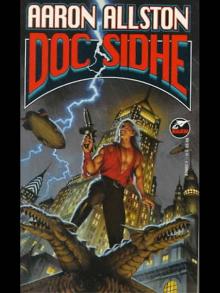 Doc Sidhe
Doc Sidhe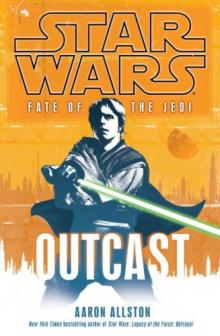 Star Wars: Fate of the Jedi: Outcast
Star Wars: Fate of the Jedi: Outcast Fate of the Jedi: Backlash
Fate of the Jedi: Backlash Mercy Kill
Mercy Kill Rebel Stand
Rebel Stand Wraith Squadron
Wraith Squadron Star Wars: X-Wing VII: Solo Command
Star Wars: X-Wing VII: Solo Command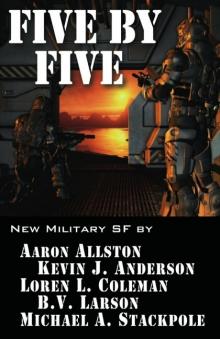 Five by Five
Five by Five Solo Command
Solo Command Star Wars: The Clone Wars Short Stories: The League of Spies
Star Wars: The Clone Wars Short Stories: The League of Spies Sidhe-Devil
Sidhe-Devil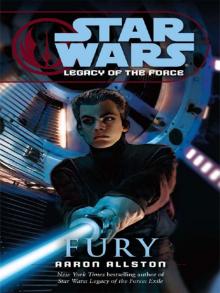 Star Wars: Legacy of the Force: Fury
Star Wars: Legacy of the Force: Fury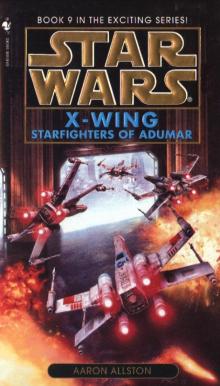 Starfighters of Adumar
Starfighters of Adumar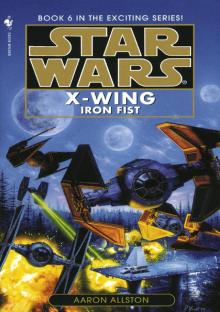 Star Wars: X-Wing VI: Iron Fist
Star Wars: X-Wing VI: Iron Fist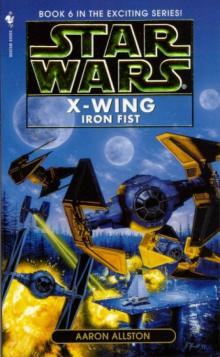 Star Wars - X-Wing - Iron Fist
Star Wars - X-Wing - Iron Fist Exile
Exile Star Wars: X-Wing V: Wraith Squadron
Star Wars: X-Wing V: Wraith Squadron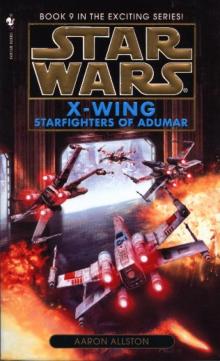 Star Wars - X-Wing - Starfighters of Adumar
Star Wars - X-Wing - Starfighters of Adumar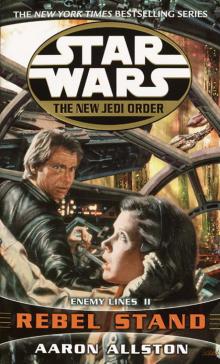 Rebel Stand: Enemy Lines II
Rebel Stand: Enemy Lines II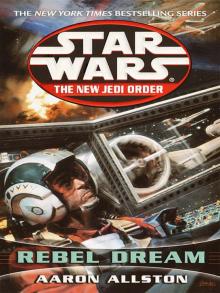 Rebel Dream: Enemy Lines I
Rebel Dream: Enemy Lines I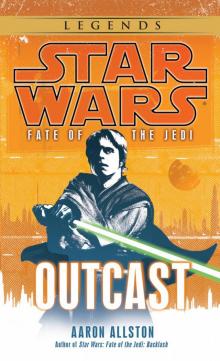 Outcast
Outcast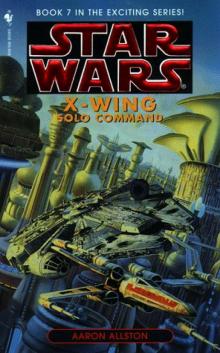 Star Wars - X-Wing 07 - Solo Command
Star Wars - X-Wing 07 - Solo Command